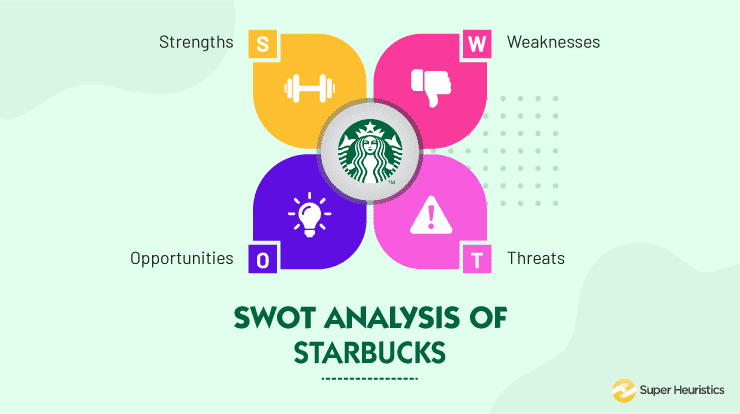Financial Performance and Global Presence: Starbucks continues to demonstrate robust financial performance. In 2022, the company reported revenue of $32.25 billion and a net income of $3.282 billion. This strong financial foundation has allowed Starbucks to expand its global footprint, operating in 81 markets with 33,833 coffeehouses across 81 countries. Its widespread presence positions it as a leader in the coffee and beverage industry.
Brand Recognition and Reputation: Starbucks boasts a powerful brand image. Its name is synonymous with quality, excellence, and a premium coffee experience. Consumers have a top-of-mind recall when it comes to Starbucks, making it their go-to choice for coffee and related products. This intangible strength contributes significantly to the company’s dominant position in the worldwide market for coffee and beverages.
Diverse Product Mix and Pricing Strategy: As the largest coffeehouse globally, Starbucks leverages its size and high volumes to offer a diverse product range. It caters to both premium and middle-tier consumers. Whether you’re seeking an indulgent specialty drink or a simple cup of coffee, Starbucks has options for everyone. This flexibility in pricing allows the company to attract a broad customer base.
People Management and Employee Satisfaction: Starbucks stands out for its progressive people management practices. In an industry where soft skills matter, the company prioritizes employee well-being. Associates benefit from a positive and welcoming workplace, resulting in superior customer service. Happier employees translate to better overall performance for Starbucks.
Weaknesses of Starbucks
Dependency on Coffee Beans and Price Sensitivity: Starbucks heavily relies on coffee beans as its primary input. Consequently, the company’s profitability is acutely sensitive to fluctuations in coffee bean prices. To mitigate this risk, Starbucks should diversify its product range beyond coffee-related offerings. By reducing dependence on coffee beans, the company can better navigate price volatility.
Ethical Procurement Challenges: In recent times, Starbucks has faced criticism regarding its procurement practices. Social and environmental activists highlight unethical sourcing of coffee beans from impoverished third-world farmers. Additionally, accusations of violating “Fair Coffee Trade” principles have tarnished the company’s reputation. Addressing these concerns through transparent and ethical sourcing practices is crucial.
Premium Pricing and Consumer Budgets: Starbucks positions its products in the premium to middle-tier market segments. While this strategy aligns with its brand image, it excludes budget-conscious working consumers. Many opt for more affordable alternatives like McDonald’s or other outlets for their coffee needs. Starbucks should consider diversifying its pricing strategy to cater to a broader consumer base.
Breakfast Segment Competition: As compressed schedules become more common, consumers seek convenient breakfast options. Starbucks faces competition from fast-food giants like McDonald’s and Burger King in this rapidly growing segment. To stay competitive, Starbucks must expand its product range beyond beverages. Offering quick, wholesome breakfast choices could attract more customers.
Certainly! Let’s explore the exciting opportunities that lie ahead for Starbucks:
Opportunities for Starbucks
Supplier Network Expansion and Diversification: Starbucks can enhance its resilience by expanding its supplier network. Diversifying sources for inputs, beyond coffee beans, will reduce dependence on specific suppliers. This strategic move will make Starbucks less sensitive to coffee bean price fluctuations and mitigate supply chain risks.
Emerging Markets Expansion: The emerging markets of China and India present a golden opportunity for Starbucks. As over a billion consumers seek instant coffee and breakfast options, Starbucks can strategically expand into these countries. By tailoring its offerings to local preferences, Starbucks can tap into this vast consumer base.
Broadening Product Offerings: Starbucks can venture beyond beverages and take on the full spectrum of food and beverage retailers. Competing with giants like McDonald’s and Burger King, Starbucks can diversify its menu to attract a wider audience. Breakfast items, snacks, and innovative food options can enhance its appeal.
Retail Store Network Growth: Starbucks can aggressively expand its retail presence in the United States. By opening more stores strategically, the company can capture greater market share and cater to diverse consumer segments. This expansion aligns with the global growth opportunities and reinforces Starbucks’ brand presence.
Certainly! Let’s delve into the potential threats that Starbucks faces:
Threats of Starbucks
Rising Coffee Bean Prices and Supply Chain Risks: Starbucks heavily relies on coffee beans, a critical input for its products. Fluctuations in coffee bean prices pose a significant threat to the company’s profitability. Additionally, supply chain disruptions can impact the availability and cost of coffee beans.
Trademark and Copyright Infringements: Lesser-known competitors often attempt to capitalize on Starbucks’ success by infringing on its trademarks and copyrights. Starbucks has engaged in legal battles to protect its brand and iconic logo. These infringements pose reputational risks and may dilute the brand’s uniqueness.
Local Competition from Coffeehouses and Specialty Stores: Starbucks faces fierce competition from local coffeehouses and specialty stores. These establishments cater to niche consumer segments and often have loyal clienteles. While Starbucks is a global brand, it must contend with the appeal of smaller, community-oriented coffee shops.
Saturation in Developed Markets: Starbucks has traditionally relied on developed markets, where its presence is well-established. However, these markets are now saturated. To sustain growth, Starbucks must explore new avenues, such as emerging markets, where demand for coffee and beverages is rising.
Global Supply Chain Vulnerabilities: Starbucks’ extensive global supply chain exposes it to various risks. Disruptions due to geopolitical events, natural disasters, or labor issues can impact the availability of ingredients, logistics, and overall operations. The company must proactively manage these challenges.

